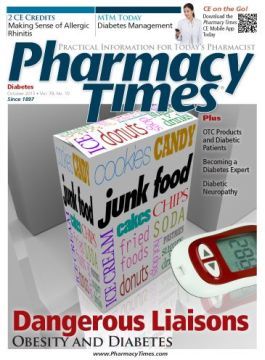Publication
Article
Pharmacy Times
Mechanical Valve Replacement and Diabetics on Antithrombotics
Author(s):
Issues in anticoagulation relating to mechanical valve replacement and diabetes patients on antithrombotics.

The recent evolution of antithrombotic therapy has led many clinicians, patients, and researchers to believe that there may be a “light at the end of the tunnel” with respect to the burden of anticoagulation management. Recent evidence shows that the burden has begun to be lifted for indications such as atrial fibrillation and venous thromboembolism: trials have demonstrated noninferiority and, in some instances, superiority of novel oral therapies versus warfarin.
On the heels of these findings is the thought that the 4 million patients (and growing) who have received a prosthetic heart valve replacement might benefit from these agents. Recent preclinical studies suggested a favorable trend toward efficacy in the mechanical valve population.1-3 This trend may have been discredited by Eikelboom et al with the early termination of the Randomized, Phase II Study to Evaluate the Safety and Pharmacokinetics of Oral Dabigatran Etexilate in Patients after Heart Valve Replacement (RE-ALIGN).4 The initial study was slated for 12 weeks, with the option to participate in an extension trial of up to 84 months. Patients were randomized to the dabigatran arm for either 3 to 7 days or >3 months after valve-replacement surgery or to the warfarin arm.
With the primary aim of prevention of thromboembolic complications in patients with mechanical heart valves, it was found that patients enrolled in the dabigatran arms experienced excess thromboembolic and bleeding events compared with patients in the warfarin arm. Notably, the majority of patients experiencing major bleeding episodes (pericardial bleeding within 2 weeks after surgery) or thromboembolic events (typically within the first 90 days) were patients who had undergone more recent surgical intervention.
The FDA and European Medicines Agency recommendations against the use of dabigatran in the mechanical heart valve population stand and have likely been reinforced by these results. While it is unlikely that this patient population will reap the benefits of what was seemingly the ideal anticoagulant, alternatively, a viable option for improvement in quality of life on warfarin may be patient self-testing and/or patient self-management of the international normalized ratio (INR).
Practical Considerations for Diabetics on Antithrombotics
It is well known that diabetic patients are at risk for micro- and macrovascular complications. Coronary artery disease, peripheral artery disease, and cerebrovascular disease are among the most common arterial complications affecting diabetics that result in antiplatelet therapy. Less eminent is the risk of venous thrombosis within this population. Taking into account the progression of vascular compromise in a diabetic patient, one might recall that hyperglycemia can result in endothelial dysfunction, whereby vascular tone and blood flow may become compromised. Metabolic irregularities may lead to decreased homeostasis of calcium, nitric oxide, and other factors, resulting in platelet dysfunction. Cessation of homeostatic function can cause increased production of procoagulants and a decrease in endogenous anticoagulants, leading to hypercoagulability.
Pair these anomalous occurrences alongside the concepts proposed via Virchow’s triad—that is, hypercoagulability, hemodynamic variance (eg, stasis or turbulence of blood flow), and endothelial injury or dysfunction—and you will find the recipe for thrombosis.5 As an additional consideration, many patients have comorbidities; thus it is possible that a patient with diabetes may also have atrial fibrillation (AF). As defined within the widely used CHADS2 risk-scoring system (whereby points are assigned for congestive heart failure, hypertension, age older than 75 years, diabetes mellitus, and previous stroke/transient ischemic attack) or the more recently recognized CHA2DS2VASc risk-scoring system (which assigns additional points for vascular disease such as myocardial infarction, peripheral arterial disease, or aortic plaque; stratification based on an age range of 65-74 years; and female gender), for AF patients bearing a score of 2 or 1, respectively, the preferred treatment recommendation is an oral anticoagulant.
Given the nature of disease and its complications, it is probable that diabetic patients will receive dual, and potentially triple, antithrombotic therapy. In these instances, individual risk versus benefit should be a consideration. CHADS2 (or CHA2DS2VASc) assessment in conjunction with the patient’s HAS-BLED bleeding risk should be compared. Other considerations are potentially tighter control of the INR (eg, 2.0 to 2.5) and a reduction in aspirin dosage to <100 mg when used in conjunction with dual and triple therapies to decrease the risk of bleeding consequences.6,7
Ronelle E. Stevens, PharmD, RPh, CACP, is an advanced practice anticoagulation pharmacist for the Partners Healthcare System and an adjunct clinical assistant professor of pharmacy at Northeastern University’s Bouvé College of Health Sciences in Boston, MA. This column’s information is based on current studies but may be updated without notice with newer studies or with different populations.
References
- Maegdefessel L, Linde T, Krapiec F, et al. In vitro comparison of dabigatran, unfractionated heparin, and low-molecular weight heparin in preventing thrombus formation on mechanical heart valves. Thromb Res. 2010;126(3):e196-e200.
- McKellar SH, Abel S, Camp CL, Suri RM, Ereth MH, Schaff HV. Effectiveness of dabigatran etexilate for thromboprophylaxis of mechanical heart valves. J Thorac Cardiovasc Surg. 2011;141:1410-1416.
- Schomburg JL, Medina EM, Lahti MT, Bianco RW. Dabigatran versus warfarin after mechanical mitral valve replacement in the swine model. J Invest Surg. 2012;25:150-155.
- Eikelboom JW, Connolly SJ, Brueckmann M, et al. Dabigatran versus warfarin in patients with mechanical heart valves [published online August 31, 2013]. N Engl J Med.
- Wessels PF. Anticoagulation therapy in diabetic patients. S Afr J Diabetes Vasc Dis. 2012;9:6-7.
- Lip G, Huber K, Andreotti F, et al. European Society of Cardiology Working Group on Thrombosis. Management of antithrombotic therapy in atrial fibrillation patients presenting with acute coronary syndrome and/or undergoing percutaneous coronary intervention/ stenting. Thromb Haemost. 2010;103:13-28.
- Faxon DP, Eikelboom JW, Berger PB, et al. Anti-thrombotic therapy in patients with atrial fibrillation undergoing coronary stenting: a North-American perspective. Thromb Haemost. 2011;106:572-584.






